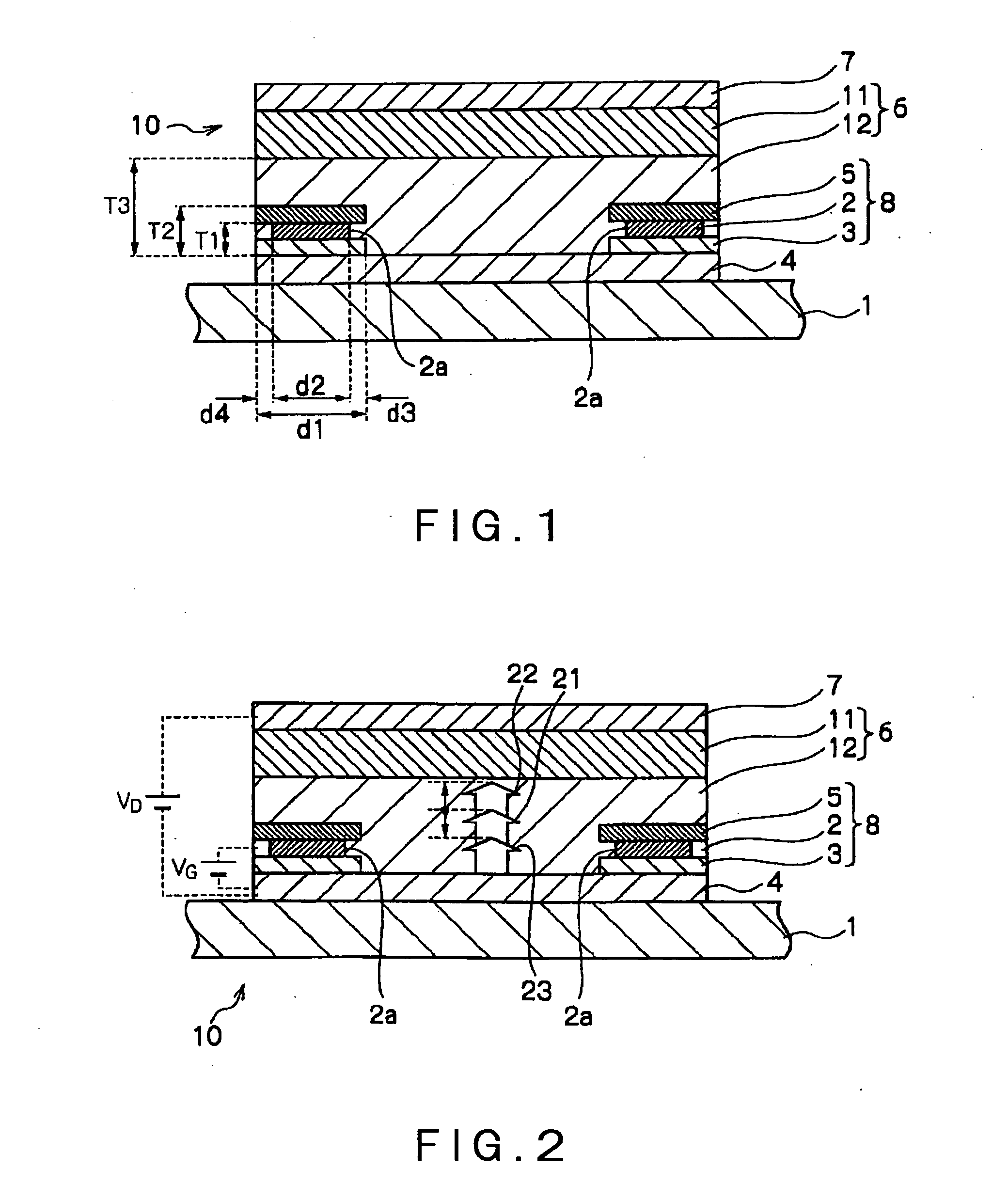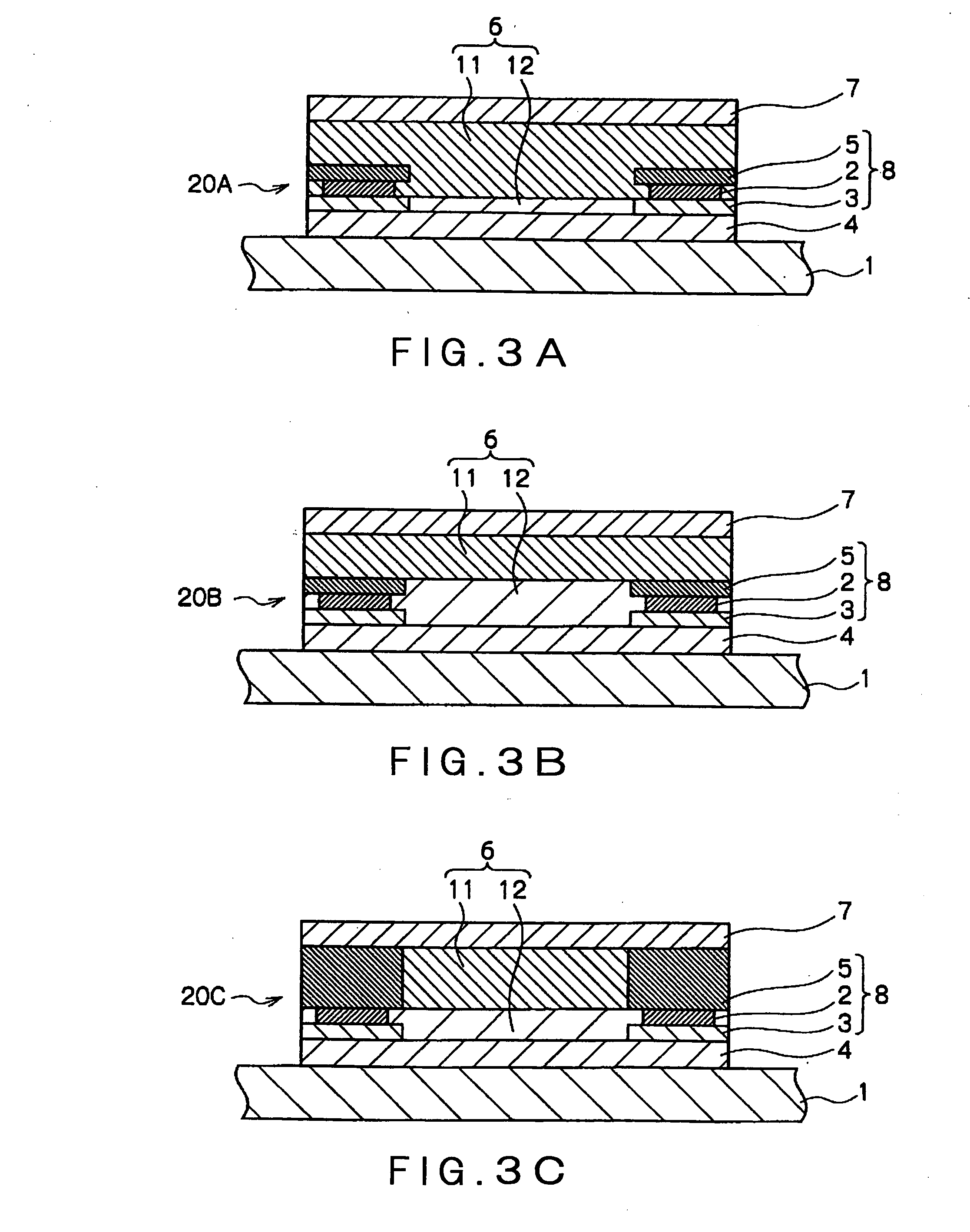Organic Luminescence Transistor Device and Manufacturing Method Thereof
a luminescence transistor and organ technology, applied in the direction of thermoelectric devices, show cards, instruments, etc., can solve the problem of difficult control of the luminescence amount, and achieve the effect of efficient manufacturing
- Summary
- Abstract
- Description
- Claims
- Application Information
AI Technical Summary
Benefits of technology
Problems solved by technology
Method used
Image
Examples
example 1
[0155]A laminar insulation layer 3′ was formed into a 100 nm thickness, by means of a sputtering of SiO2, on a glass substrate 1 having a first electrode 4 (anode) that is made of an ITO film and has a 100 nm thickness. Then, on the laminar insulation layer 3′, a resist for an etching process (manufactured by TOKYO OHKA KOGYO CO. Ltd., trade name: OFPR800) was applied into a 2 μm thickness, exposed and developed, so that a resist pattern of a comb-like shape having a wideness d1 of 100 μm was formed. By using the resist pattern as a mask, the laminar insulation layer 3′ was dry-etched and thus patterned, so that an insulation layer 3 having the comb-like shape of the thickness of 100 nm and the wideness d1 of 100 μm was formed. Thereafter, the resist for an etching process was peeled off by a peeling solution (manufactured by TOKYO OHKA KOGYO CO. Ltd., trade name: Peeling Solution 104). Next, a laminar assistance electrode 2 was formed into a 30 nm thickness, by means of a sputterin...
example 2
[0159]A polyfluorene (manufactured by AMERICAN DYE SOURCE Inc., trade name: Poly[(9,9-dioctylfluorenyl-2,7-diyl)-co-(N,N′-diphenyl)-N,N′-di(p-butylphenyl)1,4-diamino-benzene)])]) as an electric-charge injecting material was applied by means of an ink-jetting method, so that an electric-charge injection layer 12 was formed into a thickness of 200 nm, which was smaller than the thickness of the layered structure 8 (consisting of the insulation layer 3, the assistance electrode 2 and the electric-charge injection inhibiting layer 5). Except the above, in the same manner as the example 1, an organic luminescent transistor device of the example 2 as shown in FIG. 19 was manufactured.
example 3
[0160]Before the laminar insulation layer 3′ was formed on the first electrode 4, as an electric-charge (positive-hole) injection layer 12, a poly(3,4)ethylene-dioxy-thiophene / polystyrene-sulphonate (PEDOT / PSS, manufactured by BAYER AG, trade name: Baytron P CH8000) was deposited into a 80 nm thickness by means of a spin coating method, on the first electrode 4. Except the above, in the same manner as the example 1, an organic luminescent transistor device of the example 3 as shown in FIG. 20 was manufactured.
PUM
 Login to View More
Login to View More Abstract
Description
Claims
Application Information
 Login to View More
Login to View More - R&D
- Intellectual Property
- Life Sciences
- Materials
- Tech Scout
- Unparalleled Data Quality
- Higher Quality Content
- 60% Fewer Hallucinations
Browse by: Latest US Patents, China's latest patents, Technical Efficacy Thesaurus, Application Domain, Technology Topic, Popular Technical Reports.
© 2025 PatSnap. All rights reserved.Legal|Privacy policy|Modern Slavery Act Transparency Statement|Sitemap|About US| Contact US: help@patsnap.com



